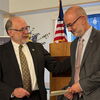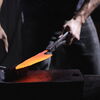Take two | The digital revolution has come at a cost for Maine's commercial photographers
But Jalbert says he'll close by the end of this year. Though he had run the only photography studio in town for decades, lately Jalbert's been bruised by a spike in competition. At least four new photography enterprises have sprung up in Fort Kent in the last couple of years, he says. "What is happening is a lot of people who have digital cameras, who call themselves photographers, they have taken a chunk of business away from us," he says. "It took me by surprise."
Though professional photographers have much to say that's positive about digital technology, the widespread changeover from film to digital technology over the past decade has left a wide wake. Full-time photographers find themselves competing more often with amateurs who have all the right equipment but none of the formal training or experience. And, for many customers, a photographer offering lower prices, as newcomers often do, is more attractive than hiring a pricier professional.
Commercial photographers say they've long been shadowed by people who believe they can take just as good a picture as a studio master, whether it's with a 35-millimeter film camera or digital point-and-shoot. But competition from amateurs is even keener these days as technology improves and becomes more affordable. Competition is so common, commercial photographers nickname the semi-pro amateurs "Digital Debbies" or "Digital Dans." The rise of Digital Dans and Debbies mean professionals have to stay a few steps ahead by building alluring websites or waging an informal crusade to convince people that photography is not an art form to be taken for granted.
The digital divide
Since the digital photography revolution swept the photography industry, most commercial photographers don't long for the days of spooling 35-millimeter film into their cameras ˆ not for nostalgia, not for sentiment, not even for artistry.
"I can't imagine shooting film," Gorham-based photographer and teacher Kate Philbrick says. "With the turnaround time, [digital] is so short. Once you've shot it and edited it, it's got to go up on the Web."
Indeed, many photographers who seized on the digital promise back in the late 1990s and early 2000s say the technology, and all they can do with it, boosted their business.
"It has been terrific," says Stephen Schaefer, owner of 35-year-old Maineline Studio in Calais. "It has been spectacular." Since going digital, Schaefer has added staff and raised salaries. Business has grown about 20% a year, he says.
In 2001, Schaefer invested $100,000 in new digital cameras and computers. At that point, though, he lost his long-time partner when he decided to opt out rather than retrain. "I had a partner who retired at age 65 who didn't want to handle the digital [equipment]," Schaefer explains. But forging ahead himself, Schaefer and his four full-timers and five part-timers took advantage of digital technology's new range for artists. "I think we're able to deliver more with less," Schaefer says.
He does, though, admit digital dabblers are a threat. But he says the best way to compete is the traditional way to compete ˆ by offering a superior product. "What we have to do is keep our product better than what they can create at home," he says. "That is our challenge and responsibility."
Dan Rodrigue, who opened Studio 1 Photography in Dresden in 1982 and another studio in Portland in 1992, says the digital revolution has been a double-edged sword. On one hand, some potential clients may turn to friends or neighbors for their photography needs. But on the other hand, Rodrigue has been able to expand client offerings. He can now provide clients with manipulated images that are more creative, for example, or promise to fix flaws like unkempt bangs or an unflattering expression using a process known as "head-switching."
While it has been personally satisfying, perhaps, for photographers to reclaim the post-production process ˆ work they used to outsource to film-developing shops ˆ they also have had to buy and frequently update new cameras, computers and software. Plus, they spend many more hours producing their wedding albums or other prints. For some, this has meant hiking prices, which can translate to challenges competing with amateurs or a mark of distinction.
"When I was shooting film, I was charging $75 an hour," Michael Berube of Good Photos in Denmark says. "And now I charge $400 an hour." Part of that increase, he says, is normal inflation since 2002, the year he converted to digital, as well as a deliberate marketing move. "I don't want to be thought of as a discount photographer," he explains.
Berube's marketing plan is simple. He maintains an attractive, simple website that he says doesn't look like a "cookie-cutter" template. Philbrick, too, reinforces the need for a classy website that is updated frequently. Plus, she says getting her name on a search engine and linking her web address on sites that list photographers helps. "You've got to get your name out there in as many places as possible. But you have to pay attention to where your name is because you don't want to associate with a cheesy, unprofessional site in any way," she says.
Digital technology can make an artist out of just about anybody, sure, but Philbrick argues customers still value quality photos. Professional photographers who understand light, composition and posing are still going to take more compelling photographs, she says. But sometimes Philbrick has to convince clients of this. "You have to talk about their photos ˆ what does it mean to take a good photo, and how that is meant to represent your business," she says. "If it looks like an amateur [photograph], your potential client base will not take you seriously."










Comments